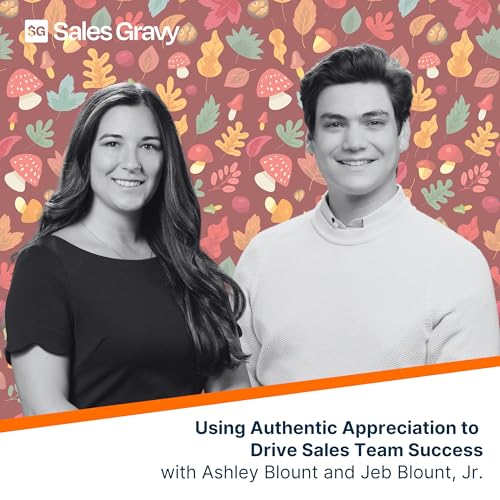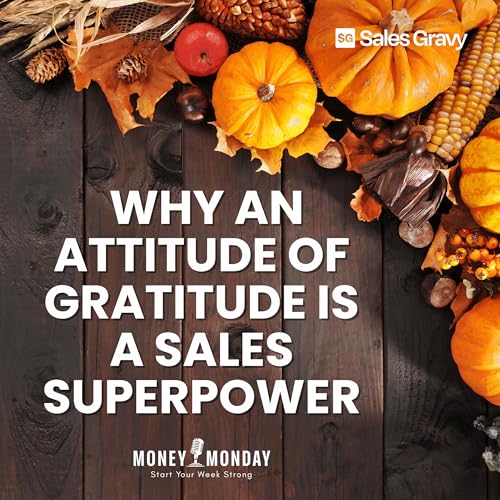This is a very special Monday because it's Thanksgiving week here in the United States. This is the week we pause to express gratitude for the people in our lives, for what we've been given, and for what we've accomplished. But gratitude isn't just a feel-good emotion reserved for the holidays. It's also a performance- and life-enhancing routine that can give you sales superpowers. Gratitude Builds a Strong Mindset Sales is a mental game. Your mindset, attitude, and beliefs have more impact on your sales outcomes and ultimate success than any technique, script, or strategy ever will. This isn't soft psychology. This is neuroscience. Gratitude activates the parts of your brain associated with reward and emotional regulation. It releases dopamine and serotonin, neurotransmitters that make you feel good, leading to increased happiness and decreased anxiety and stress. Your confidence rises, your mind clears, you gain emotional control, and you make wiser decisions. Gratitude fundamentally rewires how your brain processes the world around you. When you practice gratitude consistently, your brain shifts from focusing on what could go wrong and starts seeing what could go right. Gratitude and insidious self-pity cannot coexist. Instead of dwelling on the deal you lost, the prospect that rejected you, or the leads you don’t have, you appreciate the lessons you’ve learned and the opportunities still in front of you. But it goes deeper than just feeling better. Gratitude Builds Resilience In sales, you face rejection constantly. Bad weeks, tough months, prospects who ghost you after months of work, and deals that fall apart at the last minute, even though you did everything right. In this brutal profession, the salespeople who survive and thrive are the ones who bounce back faster from these inevitable setbacks. One of the key traits of highly successful people is an enduring belief that everything happens for a reason. When you can find something to appreciate even in difficult situations, you maintain your emotional stability. You don't spiral into negativity. You don't let one bad call ruin your entire day. Instead, you process the setback, learn from it, and move forward. Abundance vs Scarcity Thinking When you focus on what you do have—your skills, your relationships, your opportunities, your resources—you shift from scarcity thinking to abundance thinking. Scarcity thinking is the mother of negativity. It says: "I don't have enough leads. I don't have enough time. I don't have enough support. I'm going to miss my number." Abundance thinking is a mindset of opportunity and potential. It says: "Look at the skills I've developed. Look at the customers who trust me. Look at the opportunities in my pipeline. Look at what's possible." When you operate from gratitude and abundance, you become more creative, more energetic, more persistent. You stop fixating on limitations and start exploring possibilities. You show up differently. You bring positive energy. And people feel it. They want to work with people who are confident, positive, and focused on what's possible rather than what's impossible. Cultivating an Attitude of Gratitude But here’s the thing. You don't wait to feel grateful. You choose to practice gratitude. The feelings follow. Every morning, you are empowered to make a conscious choice about where to focus your attention. You can focus on what's missing, what's wrong, who’s against you, and what's hard. Or you can focus on what's present, what's working, what's possible. Both perspectives contain truth. But only one moves you forward toward the success and happiness you are seeking. Here are some practical ways to build gratitude into your daily routine: Keep a gratitude journal. Every morning or evening, write down three things you're grateful for. My friend Eric, who suffered from a severe brain injury, does this, and the impact it has had on his recovery is nothing short of a miracle. Thank someone every day. Send a text, an email, or better yet, make a phone call. Thank a customer. Thank a colleague. Thank a team member. Express genuine appreciation for something specific they've done. People naturally gravitate toward those who express genuine appreciation. When you thank a customer for their business, when you acknowledge a colleague's help, when you recognize someone's support, you strengthen those relationships. It makes you someone people want to work with, buy from, and help succeed. Mentally acknowledge the good. During your day, when something positive happens, pause for just a moment and mentally acknowledge it or say a prayer of thanks. Don't let it pass by unnoticed. Reframe challenges. When something goes wrong, ask yourself: "What can I learn from this? What opportunity might this create? What's the hidden gift in this situation?" This isn't about pretending problems don't exist. It's about looking for the lessons and possibilities within them. Start your week with ...
Voir plus
Voir moins
 14 min
14 min 16 min
16 min 26 min
26 min 14 min
14 min 13 min
13 min 35 min
35 min 22 min
22 min Nov 24 20259 min
Nov 24 20259 min
